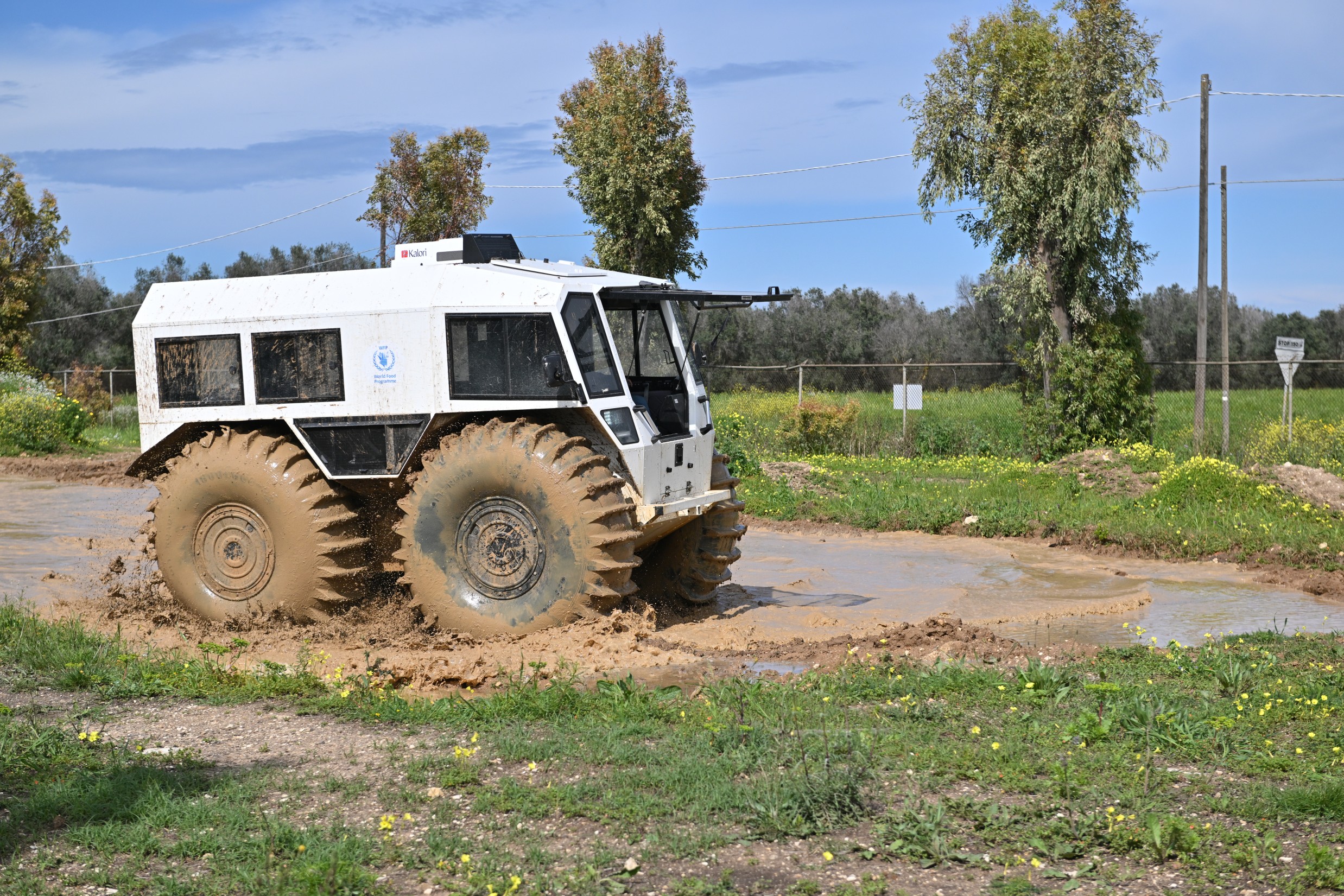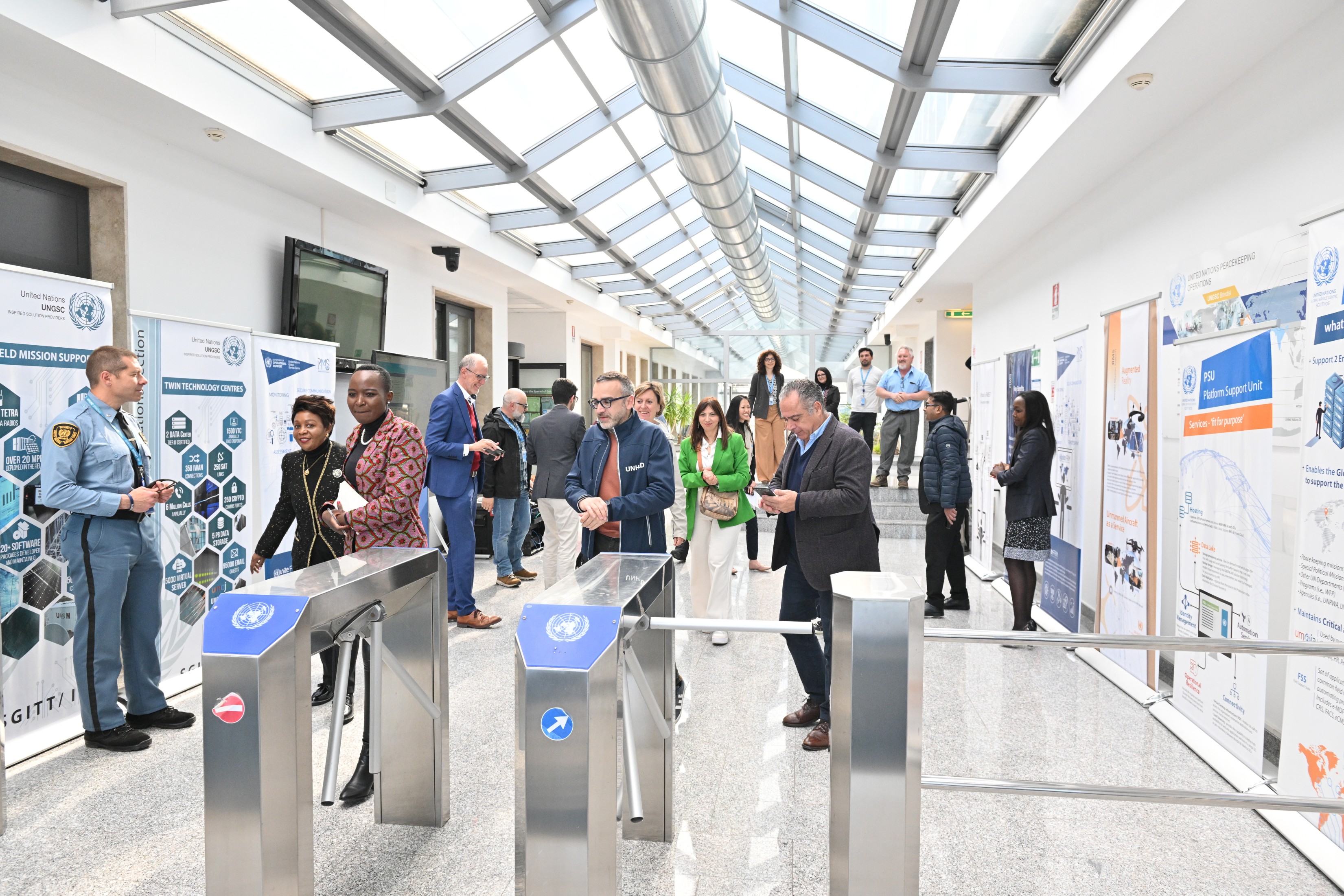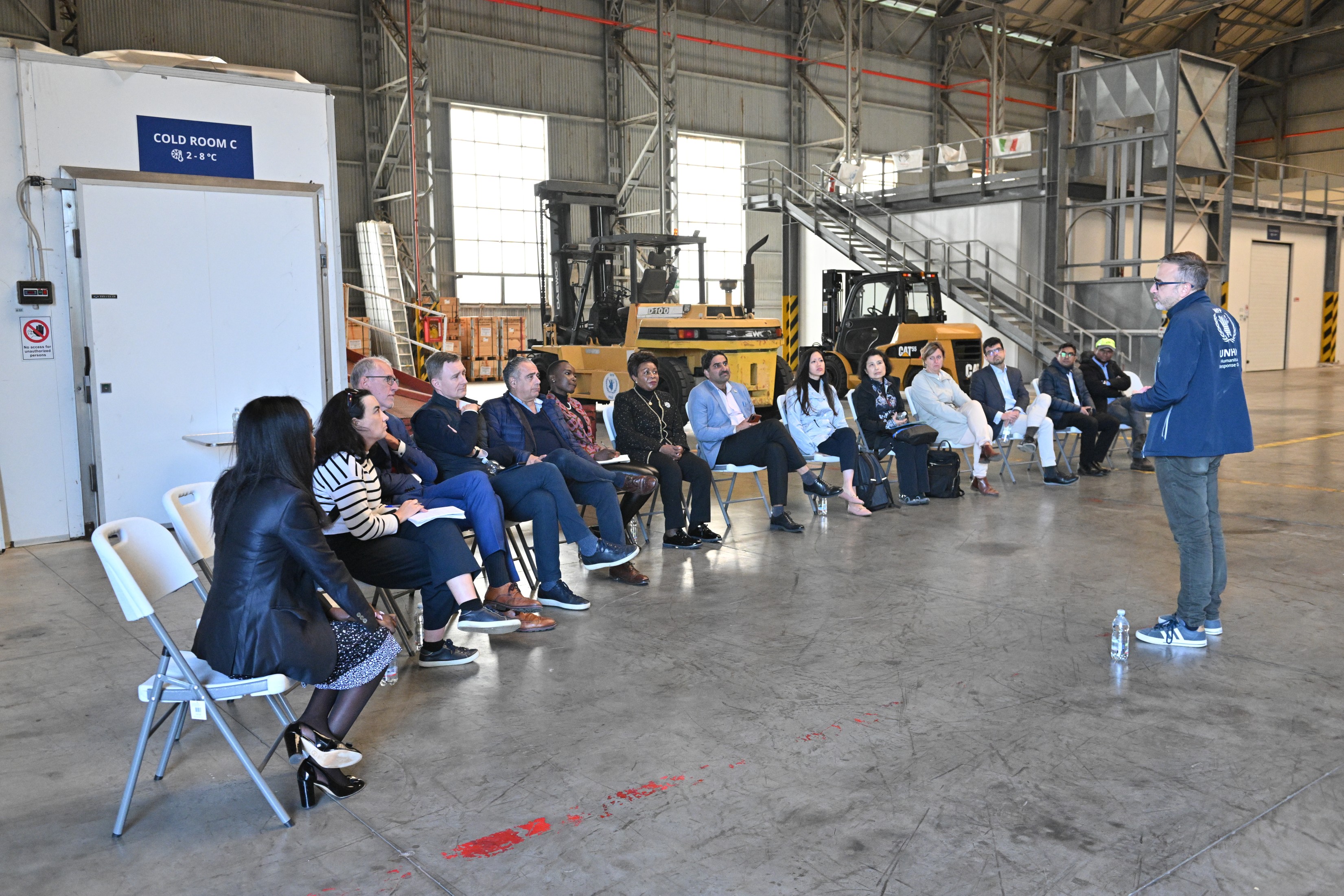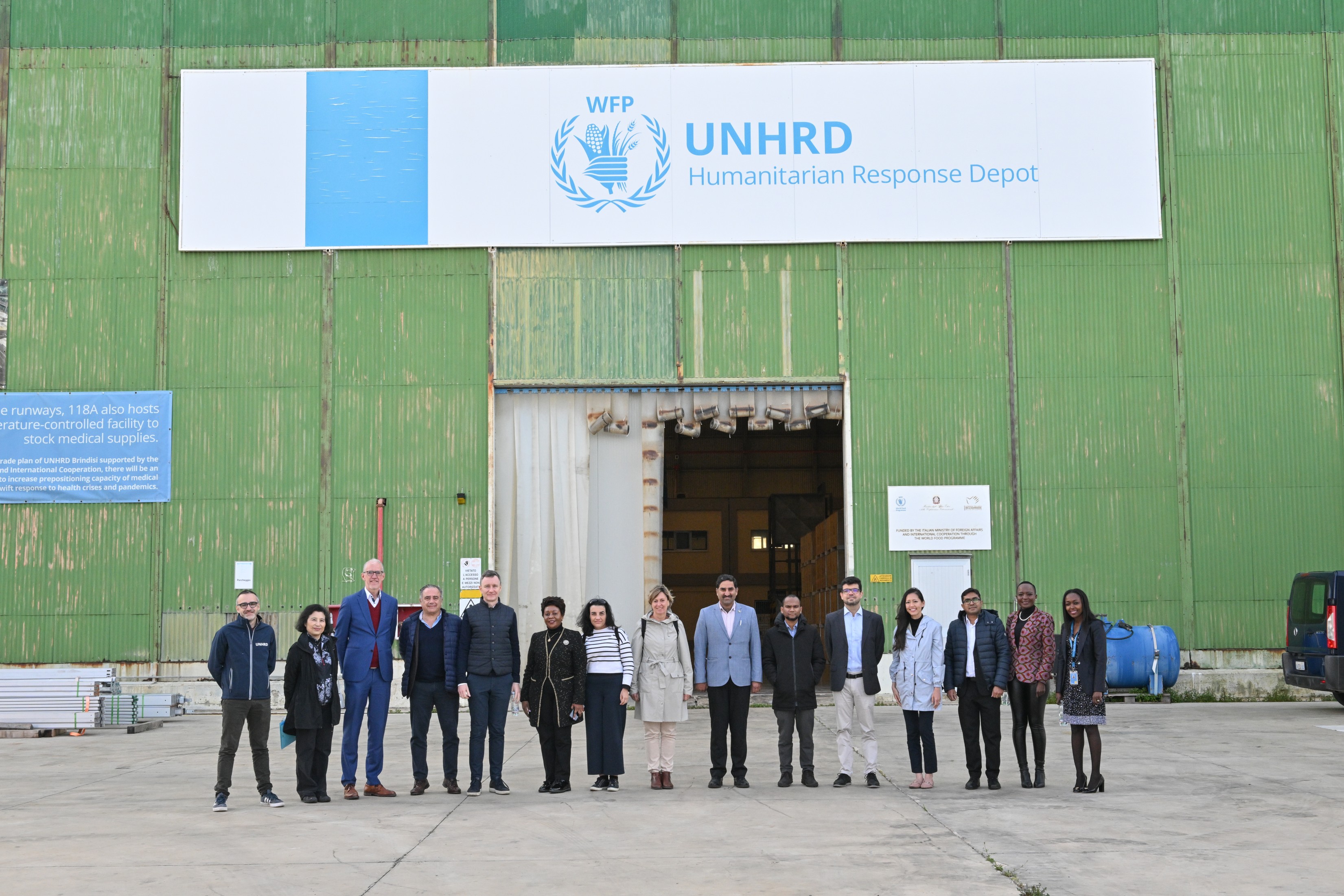An Executive Board delegation visited UNHRD facilities in Brindisi on April 18.
On 18 April, ten WFP Executive Board delegates had the opportunity to visit the United Nations Humanitarian Response Depot (UNHRD) in Brindisi, Italy. The annual one-day visit provided a valuable opportunity for the delegates to learn first-hand about the history, operations, facilities and comprehensive supply chain services of the global network that enables the global humanitarian community to effectively prepare for and respond to emergencies.
Upon disembarking at Brindisi airport, the delegation was met on the tarmac by the UNHRD team. The delegates were taken to UNHRD Brindisi premises in San Vito dei Normanni, about a fifteen-minute drive from the airport. Enroute, the delegation learned that UNHRD Brindisi is located on the site of a dismissed US Air Force base, now managed by the Ministry of Defence of Italy. The large site resembles a field location in a post-conflict setting, making it an ideal site for emergency preparedness and response training and supply chain operations.

Upon arrival at the UNHRD Hub, the delegates were welcomed by Walid Ibrahim, UNHRD Network Coordinator and Brindisi Hub Manager, who dialled in via live video call from UNHRD Dubai. He gave a brief overview of the network’s history, objectives and how it has grown from a single-location hub in 2000 to a network of five strategically located hubs around the world today – in Accra (Ghana), Brindisi (Italy), Kuala Lumpur (Malaysia), Panama City (Panama) and Dubai (United Arab Emirates). Looking ahead, he outlined the Hub’s strategy to strengthen the network to better meet the changing and complex needs of the humanitarian community in the coming years, as detailed in the newly released UNHRD 2022 year in review.

What is UNHRD? UNHRD is a network of five strategically located hubs that enable the global humanitarian community to prepare for and respond to emergencies. It is a platform that provides partners with comprehensive supply chain services, including procurement, free storage, transport, handling, and a field team with technical field expertise. In addition to its core services, UNHRD also works to develop and test innovative products for humanitarian operations through its research and development arm, the UNHRD Lab, and provides dedicated sites for humanitarian training and simulation.
Andrea Tornese, UNHRD Communication Officer who served as the group’s guide for the day then led the delegation into the museum, a specially curated exhibition area that illustrated the history of UNHRD. The exhibition highlighted key events that led to the creation of the network more than 20 years ago, and its expansion from 5 partners to over 100 partners today. The delegates also learned about the role of the hubs in enabling emergency responses, including the recent crisis in Ukraine and the earthquakes in Türkiye and Syria.
The delegates then examined a 3D model of the site, where they were briefed on the Hub’s upgrade and expansion plan with the support of the Government of Italy. This included the creation of an international conference centre, a new training and simulation centre (which would also be accessible to academia and universities) and upgrades to the UNHRD Lab – a dedicated research and development unit working on technological innovations for humanitarian operations.

The next stop of the visit was the main warehouse, a large facility that provides free storage space for a wide range of relief items and support equipment that are readily available for deployment in crisis-hit areas. The most common items stored were family tents, storage units, medical supplies, hygiene kits and blankets – most of which were unbranded to allow for lending and borrowing between partners in the event of an emergency.

Adjacent to the warehouse was a showroom, where common relief items were displayed alongside innovative products developed by the UNHRD Lab. The delegates had the opportunity to view the “Cradle Tent”, a specially designed family tent that uses green technology and the concept of upcycling to cater to the needs of an entire family in crisis situations. Once the tent is installed, the wooden crate that was used to store the tent could be converted into a rocking cradle, complete with a baby mattress, sheets, cradle cover and a teddy bear crafted from recycled materials.

The delegation then returned to the training room to learn about the INITIATE2 project through an on-screen presentation. Launched at a G20 ministerial event at UNHRD Brindisi in June 2021, INITIATE2 is a five-year initiative jointly led by WFP and the World Health Organisation (WHO). It brings together emergency response actors, research and academic institutions, and national health authorities to develop innovative and standardised products to prepare for future emergency outbreaks. An annual simulation is held at UNHRD Brindisi, with the aim of testing and fully deploying one new product each year.
Following the presentation, the delegation boarded a bus that took them through the grounds of the large former US military base to the new simulation and training area. The site, with its many dilapidated buildings, provides an ideal natural setting for scenario-based humanitarian training and simulations. Arriving at a new eight-hectare area recently secured by the Hub (with thanks to the support of the Ministry of Defence of Italy), the delegation learned about the various humanitarian training exercises that took place at the site.

The delegates then moved to an open field, where they witnessed a live demonstration of the SHERP, an amphibious all-terrain vehicle that is designed to cope with the toughest road conditions. The delegates watched intently as UNHRD staff navigated the vehicle through large boulders, mud, rocks and even water. These vehicles allow WFP to operate in many hard-to-reach areas, providing a more direct and cost-effective solution to make last mile deliveries of its nutritious food commodities to vulnerable and stranded communities.

In mid-afternoon, the delegation bid farewell to the UNHRD team at the San Vito premise as they travelled to the United Nations Global Service Centre (UNGSC) located near the airport. Situated in Brindisi, Italy and Valencia, Spain, UNGSC’s mandate is to provide critical logistics, geospatial, information and telecommunications technology services as well as training to UN entities and peacekeeping and special political missions around the world. The delegates were briefed about UNGSC’s various facilities and had the opportunity to view fleets of UN-marked armoured vehicles, buses, aircraft and field equipment on the surrounding grounds.

The visit concluded at UNHRD facilities at Brindisi military airport where the Hub was first established. Located right beside the airport, the signature green warehouse-style building contains ample storage space and temperature-controlled cold rooms, allowing for the storage and rapid transport of medicines and health kits to the nearby tarmac for onward delivery to affected populations in crisis-hit areas. At the end of the visit, the delegates had the opportunity to interact with UNHRD staff as they reflected on their immersive day at the Humanitarian Response Depot.


From left:
- WFP UNHRD Communication Officer, Mr Andrea Tornese
- WFP Deputy Secretary to the Executive Board, Ms Mihoko Tamamura
- List D Representative: H.E. Mr Joachim Bleicker, Ambassador and Permanent Representative of Germany
- List C Representative: H.E. Mr Carlos Bernardo Cherniak, Ambassador and Permanent Representative of Argentina
- List E Representative and WFP Executive Board President: H.E. Mr Artur Andrzej Pollok, Ambassador and Permanent Representative of Poland
- List A Representative: H.E. Ms Jackline Lumumba Yonga, Ambassador and Permanent Representative of Kenya
- List D Representative: H.E. Ms Céline Jurgensen, Ambassador and Permanent Representative of France
- List D Representative: Ms Irene Knoben, Alternate Permanent Representative of the Netherlands
- List B Representative: Mr Amararam Gujar, Deputy Permanent Representative of India
- List B Representative: Mr Md. Saiful Islam, First Secretary, Embassy of Bangladesh
- List C Representative: Mr Vicente Amaral Bezerra, Alternate Permanent Representative of Brazil
- WFP Executive Board Officer, Ms Anwen Chung
- List B Representative: Mr Md. Asfaqur Rahman, Alternate Permanent Representative of Bangladesh
- List A, Ms Michelle Nanjekho Holi, Second Secretary, Embassy of Kenya
- WFP UNHRD Supply Chain Officer, Diana Gobeil
- By Anwen Chung, WFP Executive Board Officer
